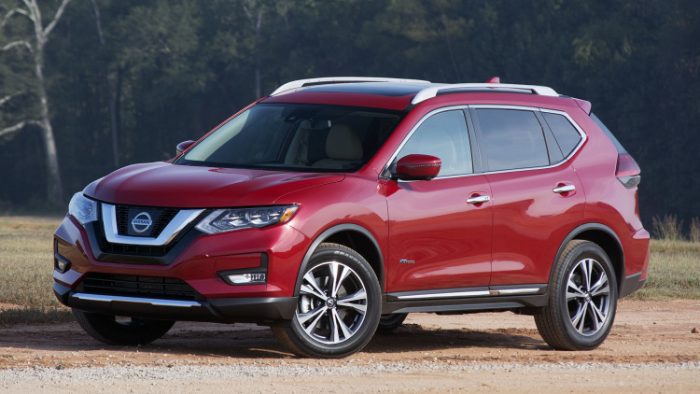Nissan And Lucasfilm
You must’ve heard by now that Nissan has linked up with Lucasfilm to create a Limited Edition of their Rogue Crossover.
This collaboration might seem like it doesn’t make any sense, but at least we are now sure that both companies share one thing in common:
They can both take a great idea and make a mess of the execution.
This sentence holds true for both the Nissan 2017 Rogue Hybrid as it does for Episode I: A Phantom Menace.
When Nissan announced the Hybrid model which is a first for this compact cross over, we were hyped, for sure, but it didn’t live up to the expectations- to say the least.
THE HYBRID
To power the Rogue Hybrid, Nissan has paired a 141-horsepower, 144-pd-ft 2.0 liter, naturally aspirated, 4-cylinder engine with a 30-KW electric motor for a net output of 176 hp.
This is more power than the 2.5liter-gas only model. The Clutch Hybrid system sounds very nice as well. They fitted one clutch between the engine and the electric motor and another one between the electric motor and the Xtronic continuously variable transmission, this is to let the engine shut down during highway driving and while coasting.
It all sounds good on paper.
Related post: Forget Everything You Know About the Micra – The New Nissan Micra
However, the two clutches suffer from bad directing, and car’s constant cycling between the engine and motor really brings the issue to the forefront.
The Rogue’s juggling is just not easy to ignore. Half a second after you dig into the throttle from a standstill and you will feel the engine and the motor arguing about where the power should come from.
TYPICAL HYBRID
Once you actually start moving, things start to brighten up. The Rogue Hybrid’s actual performance under load is quite nice. The low-end torque can almost make us forgive the car’s off-the-line behavior, and when you push the throttle hard, the car will perform similar to the standard model.
This is nice, considering that the Hybrid model has an extra 200 pounds of Hybrid powertrain on board.
However, back off, and things start to go down the hill, again.
Yes, the whole point of a hybrid system is good fuel economy, but the car shuts off the engine at every opportunity it gets.
The electric motor picks up the slack in light throttle situation, but once you push the throttle harder, the gas engine will fire up again.
That’s all fine for any hybrid, but the Rogue Hybrid’s executions is just not as good as the RAV4, its competitor from Toyota.
Of course, being a Hybrid, the Rogue uses regenerative breaking to capture energy, but here there is another issue, the brakes are grabby and difficult to modulate.
However, relative to the powertrain issues, the brakes’ unnatural reactions are not a deal breaker. Or, at the least, not THE deal breaker.
FUEL EFFICIENCY
Nissan claims the Rogue Hybrid will return 33 mpg city and 35 highway, which is 34-mpg combined rating. The All-wheel drive will bring those figures down to 31, 34 and 33, respectively. This barely beats the RAV4 Hybrid’s 32 mpg combined rating.
It’s not all bad.
It’ll be unfair to say that there’s nothing good about the Rogue Hybrid. However, everything that’s good about the Rogue Hybrid is already existent on the standard, gas-powered car, such as the smooth and competent CVT.
COMFORT & Handling
The Rogue Hybrid’s ride and handling character are pretty much the same as in the Gas-powered model.
This is good, because let’s not forget that the Hybrid model has extra 200 pounds of electric motor and batteries on board as well as low-rolling-resistance tires.
The Rogue isn’t as sharp as an M3, of course, but it’s pleasant to know that despite the addition of the Hybrid components, things didn’t turn into a mess, which happens with this type of powertrain transformation.
GOOD LOOKING
Obviously, as the Rogue Hybrid is pretty much identical to the standard car, aside from the ‘Pure Drive Hybrid’ badges.
INTERIOR
The Hybrid cabin’s has received the same refinements the standard model, with some exceptions such as the lovely tan platinum reserved interior.
The rear-mounted battery back also cuts down on space cargo, so utility is not exactly the same. The Hybrid offers 27.3 cubic feet of space with the second row all the way up, compared with 32 on the gas-powered model, and max volume is 61.4 cubic feet on the hybrid, while it is 70.0 on the standard model.
With the second row up and slid all the way back, the Hybrid offers 27.3 cubic feet of space to the standard car’s 32, while max volume is down from 70.0 to 61.4 cubic feet. Nissan hasn’t released pricing for the Rogue Hybrid yet.
MODELS & PRICES
Nissan is yet to release the pricing of the Rogue Hybrid. What we know is that it will be available in two models; the S and the SL.
The SL model will offer a number of desirable features, including LED headlights, a motion activated tailgate, heated leather seats, heated steering wheel, and a nine-speaker Bose stereo.
At the end, the Rogue Hybrid seem promising but it is rather disappointing. It still needs more polish and hopefully, Nissan will address the issues in future generations.

